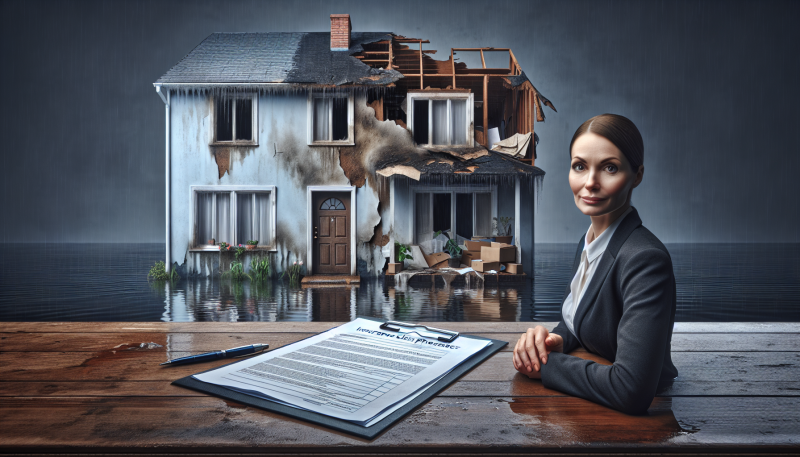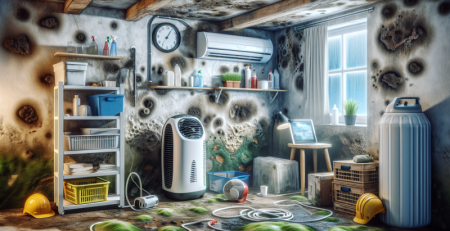Water Damage: Insurance Claims Made Easy
Experiencing water damage can be overwhelming, but navigating the insurance claims process doesn’t have to be. At Kraus Restoration, NJ’s leaders in water damage, we understand the stress and urgency that come with such incidents. Our mission is to help homeowners and property managers in Central and Northern New Jersey restore their properties and lives back to normal as swiftly as possible. With our professional 24/7 emergency services, we tackle everything from stormwater runoff and sewage backup to freeze-damaged plumbing and sump pump failures. Our IICRC certified experts are equipped to handle any water damage issue, ensuring a thorough and efficient restoration process.
In this blog, we’ll guide you through the essential steps to make your water damage insurance claims easy and stress-free. We’ll cover key aspects such as documenting the damage, understanding your insurance policy, and working with adjusters. By leveraging our expertise and comprehensive services, including mold and fire cleanup, Kraus Restoration ensures that you receive the support you need during these challenging times. Trust us to manage the tough work, from dealing with insurance companies to finding qualified contractors, so you can focus on getting your life back to normal. For immediate assistance, contact us at (973) 886 2021 or visit our website.
Understanding Your Insurance Policy for Water Damage
Understanding your insurance policy for water damage is crucial for ensuring that you are adequately protected and can navigate the claims process smoothly. Water damage can occur due to various reasons, including natural disasters, plumbing issues, or appliance malfunctions. Knowing what your insurance policy covers and how to file a claim can save you time, money, and stress. This guide will help you understand the key aspects of your insurance policy related to water damage, providing you with the knowledge needed to make informed decisions.
Types of Water Damage Covered by Insurance
Insurance policies typically cover different types of water damage, but it’s essential to understand the specifics of your policy. Here are the common types of water damage that are usually covered:
-
Sudden and Accidental Damage: This includes damage caused by sudden events such as burst pipes, accidental overflows, or appliance malfunctions. Most standard homeowner’s insurance policies cover this type of damage.
-
Weather-Related Damage: Damage caused by natural disasters like hurricanes, heavy rain, or snowstorms may be covered under your policy. However, flood damage is often excluded and requires a separate flood insurance policy.
-
Sewer Backup: Some policies offer coverage for sewer backups, but this is usually an optional add-on. It’s worth considering if you live in an area prone to such issues.
-
Mold Damage: Mold resulting from water damage may be covered if it is a direct result of a covered peril. However, mold caused by neglect or lack of maintenance is typically not covered. For more information on mold cleanup, visit our mold cleanup services page.
Exclusions and Limitations
Understanding the exclusions and limitations of your policy is just as important as knowing what is covered. Common exclusions include:
- Flood Damage: As mentioned earlier, flood damage is usually not covered under standard homeowner’s insurance policies. You will need a separate flood insurance policy for this type of coverage.
- Gradual Damage: Damage that occurs gradually over time, such as slow leaks or ongoing maintenance issues, is typically not covered. Insurance companies expect homeowners to maintain their property and address issues promptly.
- Negligence: If the damage is a result of negligence or failure to take preventive measures, your claim may be denied.
Steps to Take When Filing a Water Damage Claim
Filing a water damage claim can be a complex process, but following these steps can help ensure a smooth experience:
-
Document the Damage: Take photos and videos of the affected areas as soon as you notice the damage. This documentation will be crucial when filing your claim.
-
Contact Your Insurance Company: Notify your insurance company as soon as possible. Provide them with all the necessary information and documentation.
-
Mitigate Further Damage: Take steps to prevent further damage, such as shutting off the water supply or covering damaged areas. Your policy may require you to take reasonable measures to mitigate damage.
-
Get Professional Help: Consider hiring a professional restoration company to assess and repair the damage. For expert water cleanup services, visit our water cleanup services page.
-
Keep Records: Maintain detailed records of all communications with your insurance company, including emails, phone calls, and receipts for any expenses incurred during the mitigation and repair process.
Understanding Your Deductible and Coverage Limits
Your insurance policy will have a deductible and coverage limits that you need to be aware of:
- Deductible: This is the amount you are responsible for paying out of pocket before your insurance coverage kicks in. Make sure you know your deductible amount and factor it into your financial planning.
- Coverage Limits: Your policy will have limits on the amount it will pay for different types of damage. Ensure that your coverage limits are adequate to cover potential water damage scenarios.
Importance of Regular Maintenance
Regular maintenance can help prevent water damage and ensure that your insurance claims are not denied due to negligence. Here are some maintenance tips:
- Inspect Plumbing: Regularly check your plumbing for leaks or signs of wear and tear. Address any issues promptly to prevent significant damage.
- Maintain Appliances: Ensure that appliances like washing machines, dishwashers, and water heaters are in good working condition and serviced regularly.
- Clean Gutters: Keep your gutters clean and free of debris to prevent water from backing up and causing damage to your home.
Conclusion
Understanding your insurance policy for water damage is essential for protecting your home and ensuring a smooth claims process. By knowing what is covered, the exclusions and limitations, and the steps to take when filing a claim, you can be better prepared to handle any water damage situation. Regular maintenance and prompt action can also help prevent damage and ensure that your claims are not denied.
For more information on our services and how we can help you with water damage restoration, visit our services page. If you have any questions or need assistance, feel free to contact us.
References and Examples
Here are some references and examples to further illustrate the points discussed:
- According to the Insurance Information Institute, water damage and freezing account for almost 29% of all homeowner insurance claims in the United States.
- The Federal Emergency Management Agency (FEMA) states that just one inch of floodwater can cause up to $25,000 in damage to your home.
- A study by the American Insurance Association found that homes with poor maintenance are more likely to experience water damage, leading to higher insurance premiums and denied claims.
By understanding your insurance policy and taking proactive steps, you can protect your home from water damage and ensure a hassle-free claims process.
Steps to File a Water Damage Insurance Claim
Filing a water damage insurance claim can be a daunting task, especially when you’re already dealing with the stress of the damage itself. However, understanding the steps involved can make the process much smoother and increase your chances of a successful claim. This guide will walk you through the essential steps to file a water damage insurance claim, ensuring you get the compensation you deserve.
Step 1: Assess the Damage
The first step in filing a water damage insurance claim is to assess the extent of the damage. Take a thorough look at the affected areas and make a detailed list of all the items that have been damaged. This includes furniture, electronics, flooring, and any structural damage to your home. It’s crucial to document everything meticulously, as this will serve as evidence when you file your claim.
Step 2: Review Your Insurance Policy
Before you proceed with filing a claim, it’s essential to review your insurance policy to understand what is covered. Water damage can result from various sources such as burst pipes, natural disasters, or appliance malfunctions, and not all types of water damage may be covered under your policy. Familiarize yourself with the terms and conditions, including any exclusions or limitations, to avoid any surprises later on.
Step 3: Contact Your Insurance Company
Once you have a clear understanding of your policy, the next step is to contact your insurance company. Notify them of the water damage as soon as possible, as most insurance policies require prompt reporting. Provide them with all the necessary details, including the date and cause of the damage, and be prepared to answer any questions they may have.
Step 4: Document the Damage
Proper documentation is crucial when filing a water damage insurance claim. Take photographs and videos of the affected areas and damaged items. Make sure to capture the extent of the damage from multiple angles. Additionally, keep a written record of all the damaged items, including their approximate value and purchase date. This documentation will serve as evidence to support your claim.
Step 5: Mitigate Further Damage
Insurance policies often require policyholders to take reasonable steps to prevent further damage. This means you should take immediate action to mitigate the damage, such as shutting off the water supply, removing standing water, and drying out the affected areas. Keep receipts for any expenses incurred during this process, as they may be reimbursable under your policy.
Step 6: Schedule an Adjuster Visit
After you have reported the damage and documented everything, your insurance company will likely send an adjuster to assess the damage in person. The adjuster will inspect the affected areas, review your documentation, and determine the extent of the damage. Be sure to provide them with all the evidence you have gathered and answer any questions they may have.
Step 7: Obtain Repair Estimates
To support your claim, you will need to obtain repair estimates from reputable contractors. Contact multiple contractors to get detailed estimates for the cost of repairs. Make sure the estimates include a breakdown of labor and materials. Submit these estimates to your insurance company along with your claim.
Step 8: File Your Claim
With all the necessary documentation and repair estimates in hand, you are now ready to file your claim. Most insurance companies allow you to file a claim online, over the phone, or through their mobile app. Follow the instructions provided by your insurance company and submit all the required documents. Be sure to keep copies of everything for your records.
Step 9: Follow Up
After filing your claim, it’s important to follow up with your insurance company regularly. Keep track of the progress and stay in touch with your claims adjuster. If there are any delays or issues, address them promptly to avoid any unnecessary complications.
Step 10: Review the Settlement Offer
Once your claim has been processed, your insurance company will provide you with a settlement offer. Review the offer carefully to ensure it covers all the damages and expenses you have incurred. If you believe the offer is insufficient, you have the right to negotiate or dispute the settlement. Provide additional evidence if necessary to support your case.
Step 11: Complete the Repairs
After accepting the settlement offer, you can proceed with the repairs. Hire a reputable contractor to complete the work and keep all receipts and invoices. Once the repairs are done, submit the final documentation to your insurance company to close the claim.
Step 12: Learn and Prepare for the Future
Filing a water damage insurance claim can be a learning experience. Take note of any challenges you faced during the process and use this knowledge to better prepare for the future. Consider taking preventive measures to protect your home from water damage, such as installing a sump pump, sealing cracks, and maintaining your plumbing system.
By following these steps, you can navigate the process of filing a water damage insurance claim with confidence. Remember, thorough documentation and prompt action are key to a successful claim. If you need professional assistance with water damage cleanup, consider reaching out to experts like Kraus Restoration. They offer a range of services to help you restore your home and get back to normal.
For more information about Kraus Restoration and their services, visit their About page or contact them directly. Whether you need help with water cleanup, mold remediation, or fire damage restoration, their team of professionals is ready to assist you.
In conclusion, navigating the complexities of water damage and the subsequent insurance claims process can be daunting, but it doesn’t have to be. By understanding your policy, documenting the damage meticulously, and communicating effectively with your insurance provider, you can streamline the claims process and ensure you receive the compensation you deserve. Remember, preparation and knowledge are your best tools in mitigating the stress and financial burden that water damage can bring. Stay informed, stay proactive, and you’ll find that managing water damage insurance claims can indeed be made easy.










